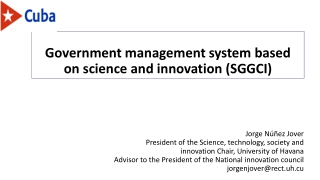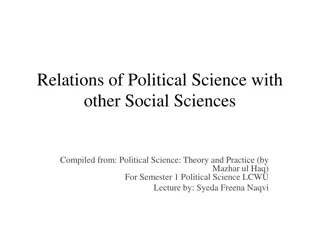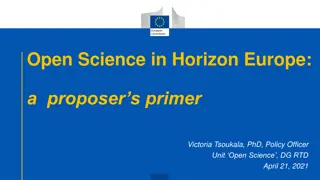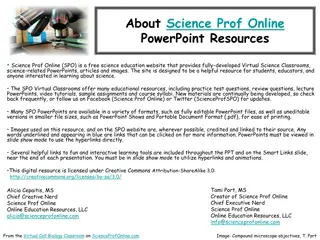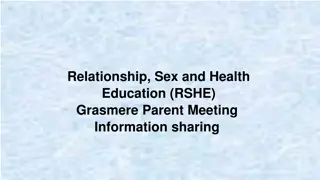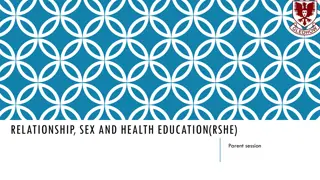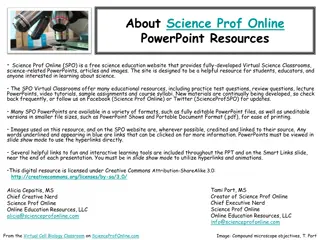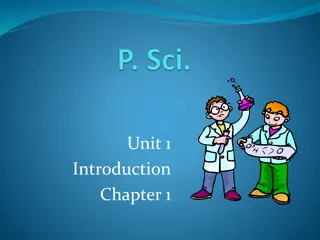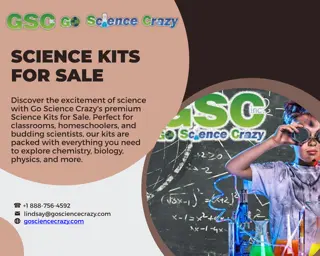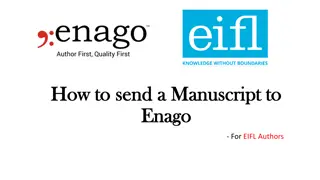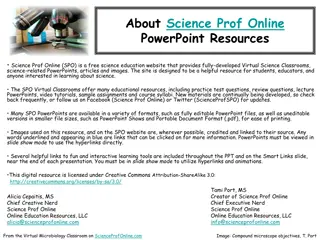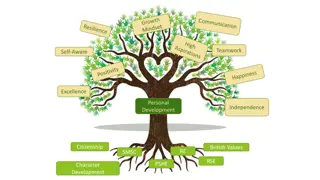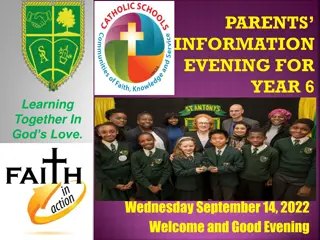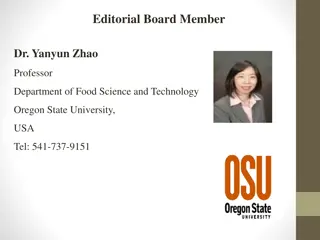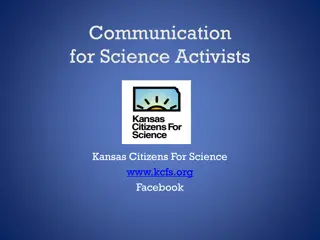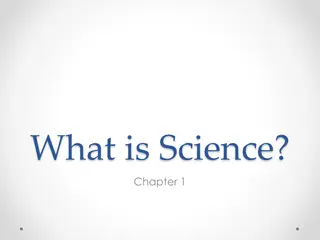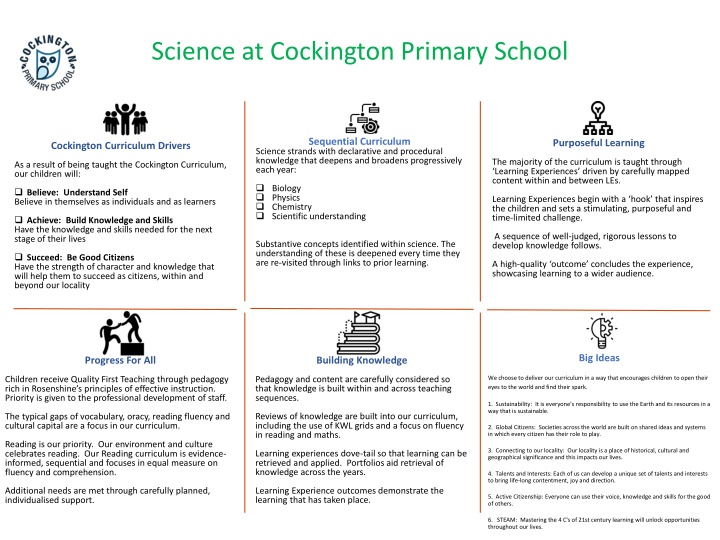
Purposeful Learning at Cockington Primary School
"Discover how science education at Cockington Primary School focuses on building deep scientific understanding, fostering belief in oneself, achieving knowledge and skills, and promoting good citizenship. The curriculum integrates sustainability, global citizenship, connections to locality, talents, active citizenship, and STEAM learning. Explore the sequential curriculum drivers, long-term planning, and seasonal topics that aim to inspire and engage young minds through outdoor learning experiences."
Download Presentation

Please find below an Image/Link to download the presentation.
The content on the website is provided AS IS for your information and personal use only. It may not be sold, licensed, or shared on other websites without obtaining consent from the author. If you encounter any issues during the download, it is possible that the publisher has removed the file from their server.
You are allowed to download the files provided on this website for personal or commercial use, subject to the condition that they are used lawfully. All files are the property of their respective owners.
The content on the website is provided AS IS for your information and personal use only. It may not be sold, licensed, or shared on other websites without obtaining consent from the author.
E N D
Presentation Transcript
Science at Cockington Primary School Sequential Curriculum Purposeful Learning Cockington Curriculum Drivers Science strands with declarative and procedural knowledge that deepens and broadens progressively each year: The majority of the curriculum is taught through Learning Experiences driven by carefully mapped content within and between LEs. As a result of being taught the Cockington Curriculum, our children will: Biology Physics Chemistry Scientific understanding Believe: Understand Self Believe in themselves as individuals and as learners Learning Experiences begin with a hook that inspires the children and sets a stimulating, purposeful and time-limited challenge. Achieve: Build Knowledge and Skills Have the knowledge and skills needed for the next stage of their lives A sequence of well-judged, rigorous lessons to develop knowledge follows. Substantive concepts identified within science. The understanding of these is deepened every time they are re-visited through links to prior learning. Succeed: Be Good Citizens Have the strength of character and knowledge that will help them to succeed as citizens, within and beyond our locality A high-quality outcome concludes the experience, showcasing learning to a wider audience. Big Ideas Building Knowledge Progress For All Pedagogy and content are carefully considered so that knowledge is built within and across teaching sequences. Children receive Quality First Teaching through pedagogy rich in Rosenshine s principles of effective instruction. Priority is given to the professional development of staff. We choose to deliver our curriculum in a way that encourages children to open their eyes to the world and find their spark. 1. Sustainability: It is everyone's responsibility to use the Earth and its resources in a way that is sustainable. Reviews of knowledge are built into our curriculum, including the use of KWL grids and a focus on fluency in reading and maths. The typical gaps of vocabulary, oracy, reading fluency and cultural capital are a focus in our curriculum. 2. Global Citizens: Societies across the world are built on shared ideas and systems in which every citizen has their role to play. Reading is our priority. Our environment and culture celebrates reading. Our Reading curriculum is evidence- informed, sequential and focuses in equal measure on fluency and comprehension. 3. Connecting to our locality: Our locality is a place of historical, cultural and geographical significance and this impacts our lives. Learning experiences dove-tail so that learning can be retrieved and applied. Portfolios aid retrieval of knowledge across the years. 4. Talents and Interests: Each of us can develop a unique set of talents and interests to bring life-long contentment, joy and direction. Learning Experience outcomes demonstrate the learning that has taken place. Additional needs are met through carefully planned, individualised support. 5. Active Citizenship: Everyone can use their voice, knowledge and skills for the good of others. 6. STEAM: Mastering the 4 C's of 21st century learning will unlock opportunities throughout our lives.
Long Term planning Science at Cockington Primary School Intent: At Cockington we value the outdoors as another source of learning. We use the outside as an extension of our classroom. We value the learning that takes place in the outdoors and the enrichment it can bring.
Long Term planning Science at Cockington Primary School Autumn 1 Autumn 2 Spring 1 Spring 2 Summer 1 Summer 2 The Seasonal similarities, differences, patterns, and change. Seasonal change Understanding growth and change over time. Why things happen and how things work. Good health, physical exercise and keeping ourselves and others healthy and safe. Caring for living things and the environment. EYF S effects physical activity has on our bodies. Animals focus: Identifying and classifying (Beach LE) Everyday materials Animals and humans focus: human body and senses Animals and humans focus: Carrnivores, omnivores and herbivores Plants Y 1 Living things and their Habitats Uses of everyday Materials Plants Animals including humans Y2 Forces and magnets Plants Animals including humans Rocks (Stone age LE) Sound Y3 Electricity Animals including humans - Sex Ed CM jigsaw lesson 3 Animals including humans Sex ed CM jigsaw lesson 4 Light Living things and their habitats States of matter Light Y4 Living things and their habitats Properties and change of materials Forces Electricity Y5 Living things and their habitats Animals including humans - Sex ed CM jigsaw lesson 4 Evolution and inheritance (Darwin LE) Earth in Space (Space LE) Y6
Science at Cockington Primary School Content Once Upon a Time The Very Hungry Caterpillar Purposeful Learning: Hook The Three Little Pigs: Someone has left a mess in the classroom, but can the children figure out who? A trail of straw and sticks have been left behind, along with a tuft of grey fur! Who could it be? Why is there a mess? What has happened? To invite the children's parents in to share and celebrate their work (the houses they have built/ to give the gingerbread man they have designed and baked to a special person in their family). Oracy: Use of story maps for talk for writing. Use of stem sentences (e.g. I predict that the... will blow... because/ I predict that the... will not blow... because...). Reading: The Three Little Pigs. Vocabulary: Experiment, investigation, test, fair test, predict, materials, heavy, light, strong, sturdy. Cultural Capital: Children will begin to build their knowledge of investigation and experimentation. The Big Bad Wolf Experiment: Children will take part in the Big Bad Wolf Experiment. First, they will predict which materials will blow and will not blow and why by exploring different materials and describing their textures. During their predictions, they will look closely at the similaraties and differences of different natural, found objects and materials. They will discuss which materials would make a strong house like the house made from bricks, talking through the different materials and how they would work. Using a straw, the children will experiment with the different materials to see which materials would blow and which ones would not blow. To make it a fair test each blow must be of an equal amount. Using their new knowledge of materials, children will design and make their own houses. Awe and Wonder: Linked to the LE hook- someone has left a mess in the classroom, but can the children figure out who? A trail of straw and sticks have been left behind, along with a tuft of grey fur! Who could it be? Why is there a mess? What has happened? Celebration of work: The children's experiments will be shared with their parents on the Interactive Learning Diary. Creativity: Children will have the opportunity to design and make their own houses using their new knowledge and understanding of different materials. Baby caterpillars appear in each of the classrooms. How can we keep our baby caterpillars safe and well? Could invite Suzanne as WfL lead to set the challenge? Purposeful Learning: Outco me Progress for All Placing the bug houses that the children have designed and made into the outside environment. Also, sharing this in the school newsletter and on the Interactive Learning Diary to share with parents. Suzanne Lovell invited to share what they have found. Releasing the butterflies. Oracy: Use of a story map for 'The Very Hungry Caterpillar' to use for talk for writing. Use of stem sentences (e.g. A flower needs... to grow/ We can look after a caterpillar by...). Reading: The Very Hungry Caterpillar. Vocabulary related to life cycles: Life cycle, chrysallis, cocoon, egg, seed, roots, stem, leaves, growth, sunlight, shoot, stem, compost, conditions. Vocabulary related to healthy eating: healthy, hygiene, diet. Cultural Capital: Children will explore and understand life cycles and how they work. EYFS Science LE Overview The butterfly life cycle and other life cycles: Children will observe the life cycle of a butterfly from their own classrooms. They will be encouraged to think about how life cycles happen and how they work. They will also look at the life cycle of a sunflower during this time, when growing their own. Children will be encouraged to ask questions about the natural world and talk about some things they have observed. They will begin to show concern for living things when caring for the butterflies and sunflowers in their classrooms. Making fruit smoothies: Children will build on prior knowledge of healthy eating and will name and talk about the different fruits used in the story of 'The Very Hungry Caterpillar'. Children will be encouraged to understand the need for a variety of food, showing an understanding of good practices regarding a healthy diet, good health and talking about ways to keep healthy and safe. Sequential Curriculum Awe and Wonder: Linked to the LE hook- Baby caterpillars appear in each of the classrooms. How can we keep our babycaterpillars safe and well? Celebration of work: The children's experiments will be shared with their parents on the Interactive Learning Diary and in the newsletter. Outdoor environment: Children will release their butterflies outside and will design and make bug hotels for the EYFS outside area. Big Ideas
Science at Cockington Primary School ELG: To know about the importance of keeping healthy and safe (Health and self-care). To know about the similarities and differences in relation to places, objects, materials and living things. To talk about the features of their own immediate environment and how environments may vary from one another (The World). Taught Vocabulary Scientific enquiry Scientific Knowledge Term 1 Effects of physical activity on our bodies. Fitness, physical activity, exercise, strength, movement, actions, warm-up, cool-down, heart rate, thirsty, dehydration, breathless, energy. I can observe the effects of physical activity on my body. I can talk about why things happen and how things work. I can show a good understanding of how exercise can contribute to good health. I know the importance of good health, physical exercise, and a healthy diet, and can talk about ways to keep healthy and safe. I can ask questions about aspects of my familiar world, such as the place where I live or the natural world. I can begin to be interested in and describe the texture of things. I can talk about some things I have observed , such as natural and found objects. I can develop an understanding of growth, decay and changes over time. I can look closely at similarities, differences, patterns and change. I can comment about aspects of my familiar world, such as the place where I live or the natural world. I can talk about why things happen and how things work. I can talk about the features of my own immediate environment and how environments vary from one another. Term 2 Seasonalsimilarities,differences, patterns and change. Seasons, summer, Spring, Autumn, Winter, blizzard, icicle, chilly, freezing, snowflake, blustery, shiver, thunderstorm, snowstorm, frost, ice, crunchy, colourful. EYFS Science Sequential Knowledge I can ask questions about the natural world. I can talk about some things I have observed , such as animals, plants, natural and found objects. I can develop an understanding of growth, decay and changes over time. I can look closely at similarities, differences, patterns and change. I can begin to be interested in and describe the texture of things. I can talk about some things I have observed , such as natural and found objects. I can look closely at similarities,differences, patterns and change. I can comment on the natural world. I can talk about why things happen and how things work. I know about similaraties and difeerences in relation to places, objects materials and living things. Term 3 Understanding growthand change over time. Prehistoric, fossil, skeleton, predator, prey, carnivore, herbivore, meteorite, extinct,Palaeontologist. I can talk about why things happen and how things work. I know about similarities and differences in relation to objects and materials. Term 4 Why things happen and how things work(driver for LE Once Upon A Time). Experiment, investigation, test, fair test, predict, materials,heavy, light, strong, sturdy. I can ask questions about the natural world. I can talk about some things I have observed , such as plants, animals,natural and found objects. I can develop an understanding of growth, decay and changes over time. I can show care and concern for living things and the environment. I can eat a variety of food stuffs. I can look closely at similarities, differences, patterns and change. I can comment on the natural world. I can talk about why things happen and how things work. I can understand the need for a variety of food. I can show understanding that good practices regarding exercising, sleeping, eating and hygiene can contribute to a good health. I know the importance for good health of physical exercise , and a healthy diet, and talk about ways to keep healthy and safe. I know about the similarities and differences in relation to living things. I can comment on the natural world. I can talk about why things happen and how things work. I know about the similaraties and differences in relation to places, objects, materials and living things. I can talk about my own immediate environment and how environments my vary from one another. Term 5 Good health, physical exercise and keeping ourselves and others healthy and safe Driver for LE The Very Hungry Caterpillar). Life cycle, chrysallis, cocoon, egg, seed, roots, stem, leaves, growth, sunlight, shoot, stem, compost, conditions, healthy, hygiene, diet. I can ask questions about the natural world. I can talk about some things I have observed , such as plants, animals,natural and found objects. I can develop an understanding of growth, decay and changes over time. I can show care and concern for living things and the environment. I can look closely at similarities, differences, patterns and change. Term 6 Ocean, scales, seaweed, marine litter/ debris, ice, iceberg, melting, rising sea levels. Caring for living things and environments.
Science at Cockington Primary School Unit Taught Vocabulary Disciplinary Knowledge Substantive Knowledge I can identify and name a variety of common animals including fish, amphibians, reptiles, birds and mammals. I can describe and compare the structure of a variety of common animals (fish, amphibians, reptiles, birds and mammals including pets). Term 1 Amphibians, reptiles, birds, mammals, fish I can identify and classify. (Driver) Animals focus: Identifying and classifying I can gather and record data to help answer questions. I can use observations and ideas to suggest answers to questions. I can observe changes across the 4 seasons. I can observe and describe weather associated with the seasons and how day length varies. Term 2 Seasonal change Seasons, autumn, winter, spring, summer, weather, daylight Year 1 Science Curriculum I can identify and classify. I can identify and name a variety of common animals that are carnivores, herbivores and omnivores. Term Animals and humans focus: Carnivores, omnivores and herbivores Carnivore, herbivore, omnivore I can identify and classify. I can identify, name, draw and label the basic parts of the human body and say which part of the body is associated with each sense. Term 4 Animals and humans focus: human body and senses Sight, smell, hear, taste, touch, thumb, fingers, shoulder, elbow, teeth, toes, knees, mouth, nose I can perform simple tests. I can identify and classify. I can ask simple questions and recognise that they can be answered in different ways. I can distinguish between an object and the material from which it is made. I can identify and name a variety of everyday materials, including wood, plastic, glass, metal, water, and rock. I can describe the simple physical properties of a variety of everyday materials. I can compare and group together a variety of everyday materials on the basis of their simple physical properties. Term 3 Everyday materials Object, material, hard, soft, stretchy, shiny, dull, rough, bendy, smooth, waterproof, transparent, opaque, absorbent, properties, wood, plastic, metal, water, rock, glass. I can identify and name a variety of common wild and garden plants, including deciduous and evergreen trees. I can identify and describe the basic structure of a variety of common flowering plants, including trees. I can identify and classify. Term 6 Animal classification and plants Wild plant, garden plant, weed, deciduous, evergreen, roots, stem, leaves, flower, petals, fruit, seed, bulb
Science at Cockington Primary School Taught Vocabulary Scientific enquiry Scientific Knowledge I can identify and name a variety of common animals including fish, amphibians, reptiles, birds and mammals. I can describe and compare the structure of a variety of common animals (fish, amphibians, reptiles, birds and mammals including pets). Year 1 Science Sequential Knowledge Amphibians, reptiles, I can identify and classify. LE Driver How can we look after our wildlife? Conservation Protect Identify Classify wildlife Animals focus: Identifying and classifying Animals can be divided into groups (or classified) by looking at the similarities and differences between them. Animals are organised into two main groups: vertebrates (animals with a backbone) and invertebrates (animals without a backbone). Vertebrates are organised int o fish, amphibians, reptiles, birds and mammals Humans are mammals. Animals need air, water, food and shelter to survive.
Science at Cockington Primary School Taught Vocabulary Scientific enquiry Scientific Knowledge I can distinguish between an object and the material from which it is made. I can identify and name a variety of everyday materials, including wood, plastic, glass, metal, water, and rock. I can describe the simple physical properties of a variety of everyday materials. I can compare and group together a variety of everyday materials on the basis of their simple physical properties. Waterproof Properties Material Compare group LE Driver 1. There are lots of different materials such as glass, wood, plastic, rocks, water and glass. 2. Materials are used for different reasons depending on their properties. 3. Scientists ask questions and use tests to find out more about materials. 4. Some of the properties of materials are: bendy, shiny, dull rough, smooth. 5. If a material is waterproof, it means that no water can pass through it. I can perform simple tests. I can identify and classify. I can ask simple questions and recognise that they can be answered in different ways. Year 1 Science Sequential Knowledge
Science at Cockington Primary School Unit Taught Vocabulary Disciplinary Knowledge Substantive Knowledge I can ask simple questions and recognise that they can be answered in different ways. I can perform simple tests. I can identify and classify. I can notice that animals, including humans, have offspring which grow into adults. I can find out about and describe the basic needs of animals, including humans, for survival (water, food and air). I can describe the importance for humans of exercise, eating the right amounts of different types of food, and hygiene. Term 1 Animals including humans Adult, develop, life cycle, offspring, reproduce, young, survival, water, food, air, exercise, diet, hygiene, nutrition, heart rate, disease, pulse, dehydration, germs Life processes, living, dead, never living, food chain, food processes, habitat, microhabitat, depend, survive I can ask simple questions and recognise that they can be answered in different ways. I can use observations and ideas to suggest answers to questions. I can identify and classify. I can explore and compare the differences between things that are living, dead, and things that have never been alive. I can identify that most living things live in habitats to which they are suited and describe how different habitats provide for the basic needs of different kinds of animals and plants, and how they depend on each other. I can identify and name a variety of plants and animals in their habitats, including microhabitats. I can describe how animals obtain their food from plants and other animals, using the idea of a simple food chain, and identify and name different sources of food. Term 3 Africa Living things and their Habitats Year 2 Science Curriculum I can gather and record data to help answer questions. I can observe closely, using simple equipment. I can perform simple tests. I can use observations and ideas to suggest answers to questions. I can identify and classify. I can observe closely, using simple equipment. I can perform simple tests. I can use observations and ideas to suggest answers to questions. I can identify and compare the suitability of a variety of everyday materials, including wood, metal, plastic, glass, brick, rock, paper and cardboard for particular uses. I can find out how the shapes of solid objects made from some materials can be changed by squashing, bending, twisting and stretching. Term 4 Uses of everyday Materials Materials, suitability, properties, squash, bend, twist, stretch, wood, metal, plastic, glass, brick, rock, paper, cardboard I can observe and describe how seeds and bulbs grow into mature plants. I can find out and describe how plants need water, light and a suitable temperature to grow and stay healthy. Term 5 Torbay Plants Germination, sprout, shoot, seed dispersal, sunlight, temperature, nutrition, water Term 6
Science at Cockington Primary School 2020-2021 Content The Stone Age NEW in 2021 Trip to Dartmoor to investigate Stone age settlement at Hound Tor, then to minibus to Haytor to look at evidence of Iron Age (trip last completed 2017-18) Look at rocks and soil samples while we are there. (From Stone Age to Iron Age) Purposeful Learning: Hook Assembly to Y4 to showcase what they have learnt about Stone Age to Iron Age- showcasing photographs from their trip to Dartmoor, Stone Age Artwork and showcase historical pieces of writing (Y4 missed out on this topic last year 2019/20) -Also to create an interactive class museum of rocks where children are given the opportunity to handle and physically sort rocks. Invite other class to use class museum (depending of social distancing/ interaction of bubbles) Oracy: Presentation to Y4 children during Assembly about the topic and what they have learnt (Y4 missed out on this topic last year 2019/20) Cultural Capital: Knowledge of local places Reading Fluency: 'Stig of the Dump' linked text to LE T4W Text: 'Stone Age Boy'- linked text to LE Purposeful Learning: Outcome Progress for All Year 3 Science LE Overview Chemistry- focus for rocks metamorphic, sedimentary and igneous Scientific Understanding of how rocks are formed, how fossils are formed, and that soil is made from rocks and organic materials (Biology & Physics links) Sequential Curriculum Big Ideas Building Curiosity: Trip to Dartmoor, images, artefacts- rocks from all over the world- different types of rocks to sort Awe and wonder about local life in the past Big Ideas in Citizenship: Our Place in the World- links with past and local area (Dartmoor) Using the outdoor environment to enhance learning and awaken curiosity of the local area in the past and present- trip to Dartmoor . See Y1/Y2 Building Knowledge
Science at Cockington Primary School 2021-22 Content Has Torquay always been the English Riviera? Tale Blazer/ Geology expert (also a teacher at South Devon College) to host geology presentation in the hall. Children to be given hands on experience of a range of different types of rocks with explanations on how they were formed and their properties. Purposeful Learning: Hook Children to create a booklet about Torquay and the findings within the LE, including the geology to be displayed in Torquay museum. Purposeful Learning: Outcome Year 3 Science LE Overview Oracy: Presentation to parents at outcome T4W Text: Reading fluency: Cultural Capita: Knowledge of local places Individual needs met through carefully planned activities- opportunities for photographing evidence of sorting rocks rather than written recording Chemistry- focus for rocks metamorphic, sedimentary and igneous Scientific Understanding of how rocks are formed, how fossils are formed, and that soil is made from rocks and organic materials (Biology & Physics links) Progress for All Sequential Curriculum Building Curiosity: To observe and handle a range of rocks (including from Pompeii) Big Ideas in Citizenship: Focus on looking after the environment. Interests and talents discovered- to identify and signpost children for Performing Arts Club based on rehearsals and performance to parents The outdoor environment used to enhance learning- link to trip to Dartmoor, noting different types of rocks Big Ideas From Y2 Mary Anning Building Knowledge Towards Y6 - Darwin
Science at Cockington Primary School Taught Vocabulary Scientific Enquiry Scientific knowledge I can identify differences, similarities or changes related to simple scientific ideas and processes. -differences and similarities in types of rocks- to use the following video clips to identify differences and similarities in a range of rocks in classroom. https://www.bbc.co.uk/bitesize/clips/zqksb9q https://www.bbc.co.uk/bitesize/clips/zt7gkqt https://www.bbc.co.uk/bitesize/clips/zftkq6f I can use straightforward scientific evidence to answer questions or to support findings. -Look at sentence starters to support answering questions and support findings on permeability investigation. I can set up simple practical enquiries, comparative and fair tests. - Focus on observations using magnifying glasses and sorting according to properties given. Children to be given opportunity to set up own practical activity with a range of resources provided e.g sorting hoops, magnifying glasses etc. I can gather, record, classify and present data in a variety of ways to help in answering questions. --This is also linked to progress for all- recording through physically sorting and photographing grouped rocks as evidence of objective I can compare and group together different kinds of rocks on the basis of their appearance and simple physical properties. - During Hook session to have opportunities to look at a range of rocks and begin to group these, continue in class and create a classroom based 'Rock Museum' as part of the outcome. https://www.dkfindout.com/uk/earth/rock-cycle/ I can describe in simple terms how fossils are formed when things that have lived are trapped within rock. Stem video link: https://www.stem.org.uk/resources/elibrary/resource/36611/fossi ls -https://www.dkfindout.com/uk/dinosaurs-and-prehistoric- life/fossils/ - Complete activity where children can make their own 'fossils' of dinosaurs/choice of animals through making a mixture of flour/coffee etc., pressing the dinosaur/animal into mixture and let dry. See BBC link: https://www.bbc.co.uk/cbeebies/makes/presenters-making- a-fossil Fossils are formed from living matter that has been trapped within layers of rocks. Igneous, metamorphic, sedimentary, Year 3 Science Sequential Knowledge Igneous rocks are form when molten rock solidifies. magma, lava, Metamorphic rocks are formed when igneous rocks change under lots of pressure and heat. permeable, impermeable, sediment, fossilisation, Sedimentary rocks are formed when small pieces of rock make layers on top of each other over a long period of time. erosion, planetology. LE overview vocab Organis matter I can recognise that soils are made from rocks and organic matter. -To gather selection of soils to identify parts of rock and organic materials. Compare with photographs of soils from different localities. Extend by looking at different types of soils (chalky, loamy, clay, peaty, sandy, silty) soils are made from rocks and organic matter. Lava solidify Permeable Erosion
2020 2021 Science in Year 3 Taught Vocabulary Disciplinerary Knowledge Substantive Knowledge I can compare and group together different kinds of rocks on the basis of their appearance and simple physical properties. I can describe in simple terms how fossils are formed when things that have lived are trapped within rock. I can recognise that soils are made from rocks and organic matter. I can identify differences, similarities or changes related to simple scientific ideas and processes. I can use straightforward scientific evidence to answer questions or to support findings. I can set up simple practical enquiries, comparative and fair tests. Igneous, metamorphic, sedimentary, magma, lava, permeable, impermeable, sediment, fossilisation, erosion, planetology. Science at Cockington Primary School I can gather, record, classify and present data in a variety of ways to help in answering questions. I can ask relevant questions and use different types of scientific enquiries to answer them. I can report on findings from enquiries, including oral and written explanations, displays or presentations of results and conclusions. I can use results to draw simple conclusions, make predictions for new values, suggest improvements and raise further questions. I can recognise that they need light in order to see things and that dark is the absence of light. I can notice that light is reflected from surfaces. I can recognise that light from the sun can be dangerous and that there are ways to protect their eyes. I can recognise that shadows are formed when the light from a light source is blocked by an opaque object. I can find patterns in the way that the size of shadows change. Light, light source, dark, reflection, reflect, reflective, ray,, pupil, retina, shadow, opaque, translucent, transparent. I can ask relevant questions and use different types of scientific enquiries to answer them. I can set up simple practical enquiries, comparative and fair tests. I can gather, record, classify and present data in a variety of ways to help in answering questions. I can record findings using simple scientific language, drawings, labelled diagrams, keys, bar charts, and tables. I can compare how things move on different surfaces. I can notice that some forces need contact between 2 objects, but magnetic forces can act at a distance. I can observe how magnets attract or repel each other and attract some materials and not others. I can compare and group together a variety of everyday materials on the basis of whether they are attracted to a magnet, and identify some magnetic materials. I can describe magnets as having 2 poles. I can predict whether 2 magnets will attract or repel each other, depending on which poles are facing. Forces, friction, surface, magnet, magnetic field, poles, repels, attract Forces and I can ask relevant questions and use different types of scientific enquiries to answer them. I can set up simple practical enquiries, comparative and fair tests. I can make systematic and careful observations and, where appropriate, taking accurate measurements using standard units, using a range of equipment, including thermometers and data loggers. I can gather, record, classify and present data in a variety of ways to help in answering questions. I can record findings using simple scientific language, drawings, labelled diagrams, keys, bar charts, and tables. I can identify and describe the functions of different parts of flowering plants: roots, stem/trunk, leaves and flowers. I can explore the requirements of plants for life and growth (air, light, water, nutrients from soil, and room to grow) and how they vary from plant to plant. I can investigate the way in which water is transported within plants. I can explore the part that flowers play in the life cycle of flowering plants, including pollination, seed formation and seed dispersal. Roots, stem, leaves, flowers, nutrients, evaporation, fertilisation, petal, stamen, carpel (pistil), sepal, pollination, pollinator, germination, seed dispersal Babies Special & unique I can identify differences, similarities or changes related to simple scientific ideas and processes. I can use straightforward scientific evidence to answer questions or to support findings. I can identify that animals, including humans, need the right types and amount of nutrition, and that they cannot make their own food; they get nutrition from what they eat. I can identify that humans and some other animals have skeletons and muscles for support, protection and movement. Healthy, nutrients, energy, saturated fats, unsaturated fats, carbohydrates, water, fibre, protein, vitamins, minerals, vertebrate, invertebrate, muscles, tendons, joints Change Animals including I can compare and group together different kinds of rocks on the basis of their appearance and simple physical properties. I can describe in simple terms how fossils are formed when things that have lived are trapped within rock. I can recognise that soils are made from rocks and organic matter. I can identify differences, similarities or changes related to simple scientific ideas and processes. I can use straightforward scientific evidence to answer questions or to support findings. I can set up simple practical enquiries, comparative and fair tests. I can gather, record, classify and present data in a variety of ways to help in answering questions. Igneous, metamorphic, sedimentary, magma, lava, permeable, impermeable, sediment, fossilisation, erosion, planetology. 1. What are the three types of 2. Name 3 ways in
Science at Cockington Primary School Taught Vocabulary Disciplinary Knowledge Substantive Knowledge Science at Cockington Primary School I can set up simple practical enquiries, comparative and fair tests. I can gather, record, classify and present data in a variety of ways to help in answering questions. I can record findings using simple scientific language, drawings, labelled diagrams, keys, bar charts, and tables. I can ask relevant questions and use different types of scientific enquiries to answer them. I can compare how things move on different surfaces. I can notice that some forces need contact between 2 objects, but magnetic forces can act at a distance. I can observe how magnets attract or repel each other and attract some materials and not others. I can compare and group together a variety of everyday materials on the basis of whether they are attracted to a magnet, and identify some magnetic materials. I can describe magnets as having 2 poles. I can predict whether 2 magnets will attract or repel each other, depending on which poles are facing. I can recognise that they need light in order to see things and that dark is the absence of light. I can notice that light is reflected from surfaces. I can recognise that light from the sun can be dangerous and that there are ways to protect their eyes. I can recognise that shadows are formed when the light from a light source is blocked by an opaque object. I can find patterns in the way that the size of shadows change. I can compare and group together different kinds of rocks on the basis of their appearance and simple physical properties. I can describe in simple terms how fossils are formed when things that have lived are trapped within rock. I can recognise that soils are made from rocks and organic matter. Term 1 Forces and Magnets Forces, friction, surface, magnet, magnetic field, poles, repels, attract I can ask relevant questions and use different types of scientific enquiries to answer them. I can report on findings from enquiries, including oral and written explanations, displays or presentations of results and conclusions. I can use results to draw simple conclusions, make predictions for new values, suggest improvements and raise further questions. Term 2 Light Light, light source, dark, reflection, reflect, reflective, ray,, pupil, retina, shadow, opaque, translucent, transparent. Year 3 Science Curriculum I can identify differences, similarities or changes related to simple scientific ideas and processes. I can use straightforward scientific evidence to answer questions or to support findings. I can set up simple practical enquiries, comparative and fair tests. I can gather, record, classify and present data in a variety of ways to help in answering questions. Term 3 Rocks Igneous, metamorphic, sedimentary, mag ma, lava, permeable, impermeable, sediment, fossilisation, erosion, planetology. Term 4 I can ask relevant questions and use different types of scientific enquiries to answer them. I can set up simple practical enquiries, comparative and fair tests. I can make systematic and careful observations and, where appropriate, taking accurate measurements using standard units, using a range of equipment, including thermometers and data loggers. I can gather, record, classify and present data in a variety of ways to help in answering questions. I can record findings using simple scientific language, drawings, labelled diagrams, keys, bar charts, and tables. I can identify and describe the functions of different parts of flowering plants: roots, stem/trunk, leaves and flowers. I can explore the requirements of plants for life and growth (air, light, water, nutrients from soil, and room to grow) and how they vary from plant to plant. I can investigate the way in which water is transported within plants. I can explore the part that flowers play in the life cycle of flowering plants, including pollination, seed formation and seed dispersal. Term 5 Plants Roots, stem, leaves, flowers, nutrients, evaporation, fertilisation, petal, stamen, carpel (pistil), sepal, pollination, pollinator, germination, seed dispersal Babies Special & unique I can identify differences, similarities or changes related to simple scientific ideas and processes. I can use straightforward scientific evidence to answer questions or to support findings. I can identify that animals, including humans, need the right types and amount of nutrition, and that they cannot make their own food; they get nutrition from what they eat. I can identify that humans and some other animals have skeletons and muscles for support, protection and movement. Term 6 Animals, including humans Healthy, nutrients, energy, saturated fats, unsaturated fats, carbohydrates,
Science at Cockington Primary School Unit Taught Vocabulary Disciplinary Knowledge Substantive Knowledge I can set up simple practical enquiries, comparative and fair tests. I can ask relevant questions and use different types of scientific enquiries to answer them. I can make systematic and careful observations and, where appropriate, taking accurate measurements using standard units, using a range of equipment, including thermometers and data loggers. I can identify differences, similarities or changes related to simple scientific ideas and processes. I can record findings using simple scientific language, drawings, labelled diagrams, keys, bar charts, and tables. I can use results to draw simple conclusions, make predictions for new values, suggest improvements and raise further questions I can set up simple practical enquiries, comparative and fair tests. I can ask relevant questions and use different types of scientific enquiries to answer them. I can record findings using simple scientific language, drawings, labelled diagrams, keys, bar charts, and tables. I can use results to draw simple conclusions, make predictions for new values, suggest improvements and raise further questions I can compare and group materials together, according to whether they are solids, liquids or gases. I can observe that some materials change state when they are heated or cooled, and measure or research the temperature at which this happens in degrees Celsius ( C). I can identify the part played by evaporation and condensation in the water cycle and associate the rate of evaporation with temperature. Term 1 States of Matter States of matter, solids, liquids, gases, water vapor, melt, freeze, evaporate, condense, precipitation. I can identify how sounds are made, associating some of them with something vibrating. I can recognise that vibrations from sounds travel through a medium to the ear. I can find patterns between the pitch of a sound and features of the object that produced it. I can find patterns between the volume of a sound and the strength of the vibrations that produced it. I can recognise that sounds get fainter as the distance from the sound source increases. Term 2 Sound Vibration, sound wave, volume, amplitude, pitch, ear, particles, distance, soundproof, absorb sound, vacuum, eardrum Year 4 Science Curriculum Term 3 I can gather, record, classify and present data in a variety of ways to help in answering questions. I can identify differences, similarities or changes related to simple scientific ideas and processes. I can describe the simple functions of the basic parts of the digestive system in humans. I can identify the different types of teeth in humans and their simple functions. I can correctly label the internal and external parts of male and female (including other mammals) bodies that are necessary for making a baby. I understand that having a baby is a personal choice and can express how I feel about having children when I am an adult I can construct and interpret a variety of food chains, identifying producers, predators and prey. Term 4 Animals including humans LETTER Digest, oesophagus, stomach, small intestine, large intestine, excretion,rectum, herbivore, omnivore, carnivore, producer, predator, prey Unique, reproduction, Having a Baby I can use straightforward scientific evidence to answer questions or to support findings. I can report on findings from enquiries, including oral and written explanations, displays or presentations of results and conclusions. I can recognise that living things can be grouped in a variety of ways. I can explore and use classification keys to help group, identify and name a variety of living things in their local and wider environment. I can recognise that environments can change and that this can sometimes pose dangers to living things. Term 5 Living things and their habitats Organisms, life processes, respiration, sensitivity, nutrition, habitat, environment, endangered species, extinct, classification, vertebrate, invertebrate, specimen,characteristic.Criteria I can ask relevant questions and use different types of scientific enquiries to answer them. I can gather, record, classify and present data in a variety of ways to help in answering questions. I can record findings using simple scientific language, I can identify common appliances that run on electricity. I can construct a simple series electrical circuit, identifying and naming its basic parts, including cells, wires, bulbs, switches and buzzers. I can identify whether or not a lamp will light in a simple series circuit, based on whether or not the lamp is part of a complete loop with a battery. Term 6 Electricity Electricity, generate, renewable, non-renewable, appliances, battery,, circuit, electrons.
Science at Cockington Primary School Unit Taught Vocabulary Disciplinary Knowledge Substantive Knowledge I can plan different types of scientific enquiry to answer questions, including recognising and controlling variables where necessary. I can report and presenting findings from enquiries, including conclusions, causal relationships and explanations of and a degree of trust in results, in oral and written forms such as displays and other presentations. I can identify scientific evidence that has been used to support or refute ideas or arguments. I can use test results to make predictions to set up further comparative and fair tests. I can associate the brightness of a lamp or the volume of a buzzer with the number and voltage of cells used in the circuit. I can compare and give reasons for variations in how components function, including the brightness of bulbs, the loudness of buzzers and the on/off position of switches. I can use recognised symbols when representing a simple circuit in a diagram. Term 1 Electricity Circuit, symbol, cell/battery, current, amps, voltage, resistance, electrons I can explain that unsupported objects fall towards the Earth because of the force of gravity acting between the Earth and the falling object. I can identify the effects of air resistance, water resistance and friction that act between moving surfaces. I can recognise that some mechanisms including levers, pulleys and gears allow a smaller force to have a greater effect. I can describe the differences in the life cycles of a mammal, an amphibian, an insect and a bird. I can describe the life process of reproduction in some plants and animals. Term 2 Forces Forces, gravity, earth s gravitational pull, weight, mass, friction, air resistance, water resistance, buoyancy, stream lined, mechanism asexual reproduction, sexual reproduction, fertilise, gestation, life cycle, metamorphosis, pollination Year 5 Science Curriculum I can report and presenting findings from enquiries, including conclusions, causal relationships and explanations of and a degree of trust in results, in oral and written forms such as displays and other presentations. I can report and presenting findings from enquiries, including conclusions, causal relationships and explanations of and a degree of trust in results, in oral and written forms such as displays and other presentations. I can use test results to make predictions to set up further comparative and fair tests. I can record data and results of increasing complexity using scientific diagrams and labels, classification keys, tables, scatter graphs, bar and line graphs. I can take measurements, using a range of scientific equipment, with increasing accuracy and precision, taking repeat readings when appropriate. Term 3 Living things and their habitats Term 4 Animals, including humans Fertilisation, prenatal, gestation, reproduce,, life cycle, adolescence, life expectancy, infancy I can describe the changes as humans develop to old age. I can compare and group together everyday materials on the basis of their properties, including their hardness, solubility, transparency, conductivity (electrical and thermal), and response to magnets. I know that some materials will dissolve in liquid to form a solution, and describe how to recover a substance from a solution. I can use knowledge of solids, liquids and gases to decide how mixtures might be separated, including through filtering, sieving and evaporating. I can give reasons, based on evidence from comparative and fair tests, for the particular uses of everyday materials, including metals, wood and plastic. I can demonstrate that dissolving, mixing and changes of state are reversible changes. I can explain that some changes result in the formation of new materials, and that this kind of change is not usually reversible, including changes associated with burning and the action of acid on bicarbonate of soda. (Link back to previous learning on life cycles, reproduction in animals and plants) I understand that sexual intercourse can lead to conception and that is how babies are usually made . I also understand that sometimes people need IVF to help them have a baby. I appreciate how amazing it is that human bodies can reproduce in these ways Term 5 Properties and change of materials Materials, solids, liquids, gases, melting, freezing, evaporating, condensing, conductor, insulator, transparency, Dissolve, Term 6 (FOR 2021) Animals including humans - continued Fertilisation, prenatal, gestation, reproduce,, life cycle, adolescence, life expectancy, infancy conception LETTER
Science at Cockington Primary School 2020-2021 Content To Infinity and Beyond Evolution and inheritance Purposeful Learning: Hook Letter / video message from Torbay Astronomy Society visit the society will set children challenge of creating high-quality, informative eBooks gap in market Not this year Purposeful Learning: Outcome Star Gazing night -sleepover with Torbay Astronomy Society Perhaps an online gallery to show of photographs taken of nature and to show their stop motion videos of evolution. Progress for All Oracy: questioning and explaining, expanding vocabulary Vocabulary: sun, Star, moon, planet, sphere, spherical bodies, satellite, orbit, rotate, axis, geocentric model, heliocentric model, astronomer. Culture Capital: children will investigate our solar system and learn the reason for the seasons, day and night and just how small and insignificant we really are Book: Phoenix by Said Oracy: questioning and explaining, expanding vocabulary Vocabulary: Offspring, inheritance, evolution, variations, characteristics, adaptation, habitat, environment, natural selection, fossil, adaptive traits, inherited traits Culture capital: children will learn about the theory of evolution alongside the life and work of Charles Darwin. They will think about their own genetic inheritance and investigate the adaptation of animals for survival. Year 6 Science LE Overview I can identify scientific evidence that has been used to support or refute ideas or arguments. I can use test results to make predictions to set up further comparative and fair tests. can explain that unsupported objects fall towards the Earth because of the force of gravity acting between the Earth and the falling object. I can identify the effects of air resistance, water resistance and friction that act between moving surfaces. I can recognise that some mechanisms including levers, pulleys and gears allow a smaller force to have a greater effect. I can recognise that living things have changed over time and that fossils provide information about living things that inhabited the Earth millions of years ago. I can recognise that living things produce offspring of the same kind, but normally offspring vary and are not identical to their parents. I can identify how animals and plants are adapted to suit their environment in different ways and that adaptation may lead to evolution. Sequential Curriculum There is creativity and imagination in the classroom, by watching footage of the moon landings, role playing the movement of the planets relative to the sun and with the potential visits of experts. There is creativity and imagination in the classroom, using books from the Babcock texts that teach as well as show-casing scientific learning through stop-motion video creations. A practical investigation on adaptation to inspire and engage. Big Ideas The outdoor environment at school will be used to host a star gazing event as part of the outcome. The outdoor environment at home and school will be used for our photography lessons. Interests are discovered through developing an interest in evolution and inheritance. Interests are discovered through developing an interest in astronomy. Citizenship sharing knowledge of evolution through stop-motion videos. Citizenship sleepover as a residential experience
Science at Cockington Primary School 2021-2022 Content To Infinity and Beyond How did Darwin develop the theory of evolution? Purposeful Learning: Hook Letter / video message from Torbay Astronomy Society visit the society will set children challenge of creating high-quality, informative eBooks gap in market Trip to Paignton zoo to engage children - Purposeful Learning: Outcome Star Gazing night -sleepover with Torbay Astronomy Society Perhaps an online gallery to show of photographs taken of nature and to show their stop motion videos of evolution. Progress for All Oracy: questioning and explaining, expanding vocabulary Vocabulary: sun, Star, moon, planet, sphere, spherical bodies, satellite, orbit, rotate, axis, geocentric model, heliocentric model, astronomer. Culture Capital: children will investigate our solar system and learn the reason for the seasons, day and night and just how small and insignificant we really are Book: Phoenix by Said I can identify scientific evidence that has been used to support or refute ideas or arguments. I can use test results to make predictions to set up further comparative and fair tests. can explain that unsupported objects fall towards the Earth because of the force of gravity acting between the Earth and the falling object. I can identify the effects of air resistance, water resistance and friction that act between moving surfaces. I can recognise that some mechanisms including levers, pulleys and gears allow a smaller force to have a greater effect. There is creativity and imagination in the classroom, by watching footage of the moon landings, role playing the movement of the planets relative to the sun and with the potential visits of experts. Oracy: questioning and explaining, expanding vocabulary Vocabulary: Offspring, inheritance, evolution, variations, characteristics, adaptation, habitat, environment, natural selection, fossil, adaptive traits, inherited traits Culture capital: children will learn about the theory of evolution alongside the life and work of Charles Darwin. They will think about their own genetic inheritance and investigate the adaptation of animals for survival. Year 6 Science LE Overview I can recognise that living things have changed over time and that fossils provide information about living things that inhabited the Earth millions of years ago. I can recognise that living things produce offspring of the same kind, but normally offspring vary and are not identical to their parents. I can identify how animals and plants are adapted to suit their environment in different ways and that adaptation may lead to evolution. Sequential Curriculum There is creativity and imagination in the classroom, using books from the Babcock texts that teach as well as show-casing scientific learning through stop-motion video creations. A practical investigation on adaptation to inspire and engage. Big Ideas The outdoor environment at school will be used to host a star gazing event as part of the outcome. The outdoor environment at home and school will be used for our photography lessons. Interests are discovered through developing an interest in evolution and inheritance. Interests are discovered through developing an interest in astronomy. Citizenship sharing knowledge of evolution through stop-motion videos. Citizenship sleepover as a residential experience Building Knowledge
Science at Cockington Primary School Taught Vocabulary Disciplinary Knowledge Substantive Knowledge I can identify scientific evidence that has been used to support or refute ideas or arguments. I can recognise that living things have changed over time and that fossils provide information about living things that inhabited the Earth millions of years ago. I can recognise that living things produce offspring of the same kind, but normally offspring vary and are not identical to their parents. I can identify how animals and plants are adapted to suit their environment in different ways and that adaptation may lead to evolution. Term 1 Evolution and inheritance Offspring, inheritance, evolution, variations, characteristics, adaptation, habitat, environment, natural selection, fossil, adaptive traits, inherited traits I can report and presenting findings from enquiries, including conclusions, causal relationships and explanations of and a degree of trust in results, in oral and written forms such as displays and other presentations. Identify scientific evidence that has been used to support or refute ideas or arguments. I can report and presenting findings from enquiries, including conclusions, causal relationships and explanations of and a degree of trust in results, in oral and written forms such as displays and other presentations. I can report and presenting findings from enquiries, including conclusions, causal relationships and explanations of and a degree of trust in results, in oral and written forms such as displays and other presentations. I can use test results to make predictions to set up further comparative and fair tests. I can plan different types of scientific enquiry to answer questions, including recognising and controlling variables where necessary. I can take measurements, using a range of scientific equipment, with increasing accuracy and precision, taking repeat readings when appropriate. I can record data and results of increasing complexity using scientific diagrams and labels, classification keys, tables, scatter graphs, bar and line graphs. I can describe the movement of the Earth and other planets relative to the sun in the solar system. I can describe the movement of the moon relative to the Earth. I can describe the sun, Earth and moon as approximately spherical bodies. I can use the idea of the Earth s rotation to explain day and night and the apparent movement of the sun across the sky. I can explain how the seasons are caused by the Earth s orbit around the Sun. I can describe how living things are classified into broad groups according to common observable characteristics and based on similarities and differences, including micro-organisms, plants and animals. I can give reasons for classifying plants and animals based on specific characteristics. I can recognise that light appears to travel in straight lines. I can use the idea that light travels in straight lines to explain that objects are seen because they give out or reflect light into the eye. I can explain that we see things because light travels from light sources to our eyes or from light sources to objects and then to our eyes. I can use the idea that light travels in straight lines to explain why shadows have the same shape as the objects that cast them. I can identify and name the main parts of the human circulatory system, and describe the functions of the heart, blood vessels and blood. I can recognise the impact of diet, exercise, drugs and lifestyle on the way their bodies function. I can describe the ways in which nutrients and water are transported within animals, including humans. Term 2 Earth in Space Sun, Star, moon, planet, sphere, spherical bodies, satellite, orbit, rotate, axis, geocentric model, heliocentric model, astronomer. Year 6 Science Curriculum Term 3 Living things and their habitats Characteristics, classify, taxonomist, key, bacteria, microorganism, microscope, species Term 4 Light Light, light source, reflection, incident ray, reflected ray, refraction, prism, shadow, transparent, translucent, opaque, visible spectrum , Term 5 Animals, including humans Circulatory system, heart, blood vessels, oxygenated blood, deoxygenated blood, drug, alcohol, nutrients I can describe how a baby develops from conception through the nine months of pregnancy, and how it is born Term 6 (for 2021) Animals cont.LETTER Conception Birth
Science at Cockington Primary School Taught Vocabulary Scientific enquiry Scientific Knowledge I can identify scientific evidence that has been used to support or refute ideas or arguments. I can recognise that living things have changed over time and that fossils provide information about living things that inhabited the Earth millions of years ago. I can recognise that living things produce offspring of the same kind, but normally offspring vary and are not identical to their parents. I can identify how animals and plants are adapted to suit their environment in different ways and that adaptation may lead to evolution. Offspring, inheritance, evolution, variations, characteristics, adaptation, habitat, environment, natural selection, fossil, adaptive traits, inherited traits Term 1 Evolution and inheritance 1. Animals and plants are classified into groups and sub groups according to their similarities and differences. The groups (e.g. birds) are organised into subgroups of families (e.g. sparrow) which are organised into species (eg house sparrow). Animals of the same species breed more of the same species, but normally offspring vary and are not identical to their parents. Animals and plants are found in certain environments because they have adapted features that have given them a better chance to survive there. This adaptation may lead to evolution. Living things have changed over time and fossils provide information about living things that inhabited the earth millions of years ago. Year 6 Science Sequential Knowledge 2. LE vocab characteristics Inheritance Evolution Offspring Variation adaptation 3. 4. 5.
Science at Cockington Primary School Taught Vocabulary Scientific enquiry Scientific Knowledge I can report and presenting findings from enquiries, including conclusions, causal relationships and explanations of and a degree of trust in results, in oral and written forms such as displays and other presentations. Identify scientific evidence that has been used to support or refute ideas or arguments. I can describe the movement of the Earth and other planets relative to the sun in the solar system. I can describe the movement of the moon relative to the Earth. I can describe the sun, Earth and moon as approximately spherical bodies. I can use the idea of the Earth s rotation to explain day and night and the apparent movement of the sun across the sky. I can explain how the seasons are caused by the Earth s orbit around the Sun. , LE vocab Rotate Spherical Astronomer Orbit axis Term 2 Space 1. The Sun is a star at the centre of our solar system and that it has eight planets. 2. Day and night are caused by the rotation of the Earth on its own axis. 3. The Sun, Earth and Moon are spherical bodies in our solar system. 4. The seasons are caused by the Earth s orbit around the sun and the tilt of the Earth. 5. The moon orbits the Earth approximately every 28 days. Year 6 Science Sequential Knowledge

